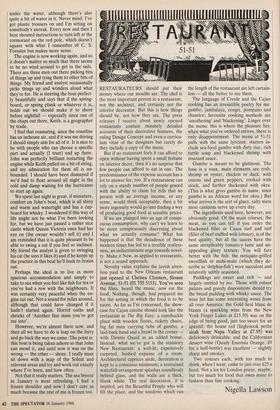III (JIll 111111 [111111 11111l11111111111MON RESTAURATEURS should put their money
where our mouths are. The chef is the most important person in a restaurant, not the architect, and certainly not the interior decorator. But this is how things should be, not how they are. The press releases I receive about newly opened restaurants contain minutely detailed accounts of their decorative features, the ruling Design Concept and even a curricu- lum vitae of the designers but rarely do they include a copy of the menu.
But if no restaurant feels it can afford to open without having spent a small fortune on interior decor, then it's no surprise that few people can afford to eat in one. The predominance of the expense account has a lot to answer for, too. If a restaurateur can rely on a sturdy number of people graced with the ability to claim for bills that no person with an average income, or any sense, would think acceptable, then a bit more ingenuity would go into finding a way of producing good food at sensible prices.
If we are plunged into an age of conspi- cuous consumption, why can't we learn to be more conspicuously discerning about what we actually consume? What has happened is that the decadence of these modern times has led to a terrible restless- ness, an indiscriminate urge towards novel- ty. Make it New, as applied to restaurants, is not a sound approach.
Novelty value explains the lavish atten- tion paid to the New Orleans restaurant just opened at Chelsea Cloisters, Sloane Avenue, 51-51 (01 735 5153). You've seen the films, heard the music, now eat the food. Nothing, though, had prepared me for the setting in which the food is to be eaten. As far as I'm concerned, the show- case for Cajun cuisine should look like the restaurant in The Big Easy; a ramshackle place with wooden floors, rickety chairs, big fat men carrying tubs of gumbo, a laid-back band and a brawl in the corner — with Dennis Quaid as an added bonus. Instead, what we've got is the statutory New Restaurant: a well-lit, expensively carpeted, hushed expanse of a room. Architectural caprices aside, decoration is kept to a conscious minimum; a restrained waterfall-arrangement splashes soundlessly behind glass, and the walls are a thick, blank white. The real decoration, it is implied, are the Beautiful People who will fill the place, and the windows which run the length of the restaurant are left curtain- less — all the better to see them.
The language of Creole and the Cajun cooking has an irresistible poetry for me: gumbo, jambalaya, congri, pompano and chaurice; favourite cooking methods are 'smothering' and 'blackening'. Linger over the menu: this is where the pleasure lies; when what you've ordered arrives, there is only disappointment. The menu at 51-51 pulls with the same lyricism: starters in- clude sea-food gumbo with dirty rice, rich turtle soup and blackened shrimp with mustard sauce.
Gumbo is meant to be glutinous. The base is a roux, main elements are crab, shrimp or oyster, chicken or duck, with onions and green peppers, cooked with stock, and further thickened with okra. (This is what gives gumbo its name, since gumbo is an African word for okra.) But what arrives is the sort of gluey, salty mess most canteens serve up every day.
The ingredients used here, however, are obviously good. Of the main colirses, the meat, as you can tell if you order the blackened fillet or Cajun surf and turf (fillet of beef stuffed with lobster), is of the best quality, but all the sauces have the same inexplicably tomato-y taste and un- appealing gluey texture. You will fare better with the fish: the mesquite-grilled swordfish or mahi-mahi (which they de- scribe as 'dolphin-fish') were succulent and relatively subtly seasoned.
Puddings are sweet and rich — and largely untried by me. Those with robust palates and greedy dispositions should try the bread pudding with whisky sauce. The wine list has some interesting wines from all over America: the Gold Seal blanc de blancs (a sparkling wine from the New York Finger Lakes at £13.50) was on the edge of being good, just too sweet for an aperitif; the house red (Inglenook petite sirah from Napa Valley at £7.95) was deliciously drinkable; and the Californian dessert wine (Quady Essensia Orange, £9 for a half-bottle) was excellent — slightly sharp and smokey.
Two courses each, with too much to drink, when I went, came to just over £25 a head. Not a lot for London prices, maybe, but too much for food that owes more to fashion than fine cooking.
Nigella Lawson


















































 Previous page
Previous page